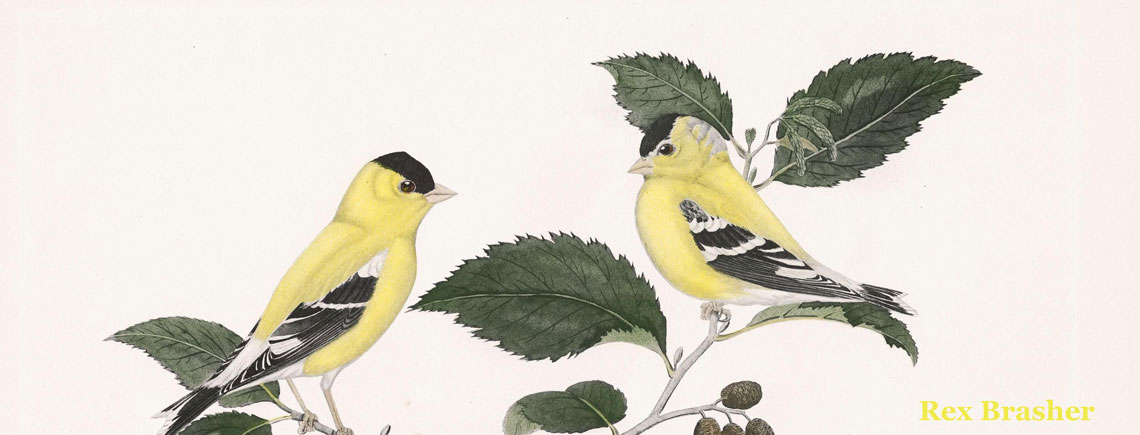The Legacy of Rex Brasher
Americans are an impatient, restless people. We embrace an idea, become obsessed with a news story or are enamored with a new technology only to move on in days, weeks, or months. Americans, on average, shift jobs 12 times during their working lives, averaging just four years in any position.
Imagine then, a quieter time, when a preoccupation could last a lifetime, when quiet persistence in achieving a goal could be its own reward. Such was the case with ornithologist/artist Reginald “Rex” Brasher, who spent decades chronicling all 1,200 bird species—and their subspecies—listed by the American Ornithological Union.
To complete his endeavor, Brasher tramped fields, forests and meadows in every state over the course of 47 years searching for birds in their natural habitats and making extensive field notes. He then took this information back to his New York studio to render the birds into works of art.
To pay for this lifestyle, Brasher bet on horse races—sometimes winning big—and worked odd jobs. His oeuvre eventually included 874 paintings, eclipsing the output of the better-known John James Audubon who never ventured west of the Mississippi.
Indeed, it was Audubon who inspired Brasher to undertake his quest—not because of the beauty of Audubon’s art but because of his rudeness. Brasher (1869-1960) was born in Brooklyn NY, son of a Wall Street stockbroker and enthusiastic amateur ornithologist who passed his love of birds on to his son. The elder Brasher had made an appointment to see Audubon while the artist was in New York City. But upon his arrival, he was brusquely turned away by Audubon who said he was too busy painting from a dead bird model.
When told the story, an incensed Rex Brasher, who had trained as an engraver with Tiffany & Co, vowed to outdo the master. He determined to paint more birds than Audubon, to paint them more realistically and in their natural settings. As he worked, decade after decade, his engraver’s eye produced remarkably accurate, delicately colored renditions of birds, some of species now lost to the world.
His determination to produce only the finest work was demonstrated when, by chance, he met and befriended eminent avian artist, Louis Agassiz Fuertes. After seeing Fuertes’ work, Brasher went home and burned the 400 paintings he’d completed. Then he started over.
In 1911 he purchased a 150-acre farm in Dutchess County NY, right on the border of Connecticut. He bought his art supplies and socialized in Kent where he was a founder of the Kent Art Association; he listed his address as Chickadee Valley, Kent. It was here that he created his magnum opus, Birds and Trees of North America.
He worked on in his unheated house, devoid of indoor plumbing and electricity in the first years and walked several miles to Kent when he needed supplies. Aided by his niece, Marie Brasher, and using stencils and an air brush, he hand-colored each print in every book in every set—some 87,000 prints in all.
Luck was not with him, however. His original goal was to sell a limited run of 100 12-volume copies for $1,200 each but his efforts to publish his Birds and Trees of North America ran afoul of the Great Depression. With Americans scrabbling to survive, he eventually raised the price and sold most of the volumes to more affluent Americans and corporations for $2,400 each.
At the peak of his productivity, Brasher achieved the recognition he sought. In 1939 his paintings were exhibited at the Explorers Hall of the National Geographic Society in Washington DC (people lined up around the block to see them) and over the years he was featured four times in Time magazine.
T. Gilbert Pearson, president of the National Audubon Society from 1920 to 1934, called Brasher’s paintings “the most beautiful things I have ever seen,”’ and even more glory was heaped on his name when the great American naturalist, John Burroughs, said, “He is the greatest bird painter of all time!”
So why is this prolific and talented artist so little remarked today? There are several reasons according to Cynthia Carter Ayres, vice-president of the Rex Brasher Association, a fledgling organization seeking to revitalize his reputation and to preserve his former home for bird and art lovers.
She relates that Brasher focused on keeping his collection together. He first offered it free to the State of Connecticut if it would build a place to display the paintings but, between the Depression and the onset of World War II, plans for a Brasher Museum at Kent Falls State Park fell by the wayside. In 1941 the State of Connecticut bought the original paintings for $72,290. They were later shown on a rotating basis at Eolia, the mansion at Harkness Memorial State Park in Waterford, but when, in 1988, curators realized the salt air was damaging them, they were removed.
The Connecticut Museum of Natural History, headquartered at the University of Connecticut in Storrs, now owns them but until they are fully conserved, the paintings can only be viewed by appointment and only a few at a time. They are effectively lost to public view and the artist’s fame has dimmed with time.
“The bulk of the portfolios are in special collections, so, like the paintings, no one can see them,” said Ayres.
The Rex Brasher Association is seeking to correct this. In 2021, RBA board member Matthew Schnepf and two student interns began to document every page in all 12 volumes. In Phase 1 they quickly captured every page in Birds and Trees of North America in high-quality photographs. Phase 2, slated for 2023, will capture each page with ultra-high-resolution scans which will provide an unprecedented view of Brasher’s work.
Some of their work is already available for viewing on www.rexbrasher.org.
The Rex Brasher Association is also in line to inherit Brasher’s former residence in Amenia from his grand-nieces, Deborah and Melode Brasher, now both deceased. As the land transfer works through the probate process, the Association is considering plans for the site.
“Our task right now is to raise money,” said Ayres. “We really want to use the property in the spirit it was given. The Brasher property is superb bird terrain and borders a preserve. Part of our thought is to get much of it into land conservancy. We are determined to make Rex’s beloved Chickadee Valley property accessible to those also seeking peace and to protect important bird habitat.”
A parcel with two buildings on it would be retained, possibly to be used for residencies by biologists or ornithologists. “We would also like to have a small museum on the property,” she added, saying Brasher works inherited with the property could be displayed there.
Noting that the University of Connecticut is again proposing a museum that would display Brasher’s works in one wing, Ayres said, “We have a good relationship with them,” and hoped for future cooperation with UConn.


